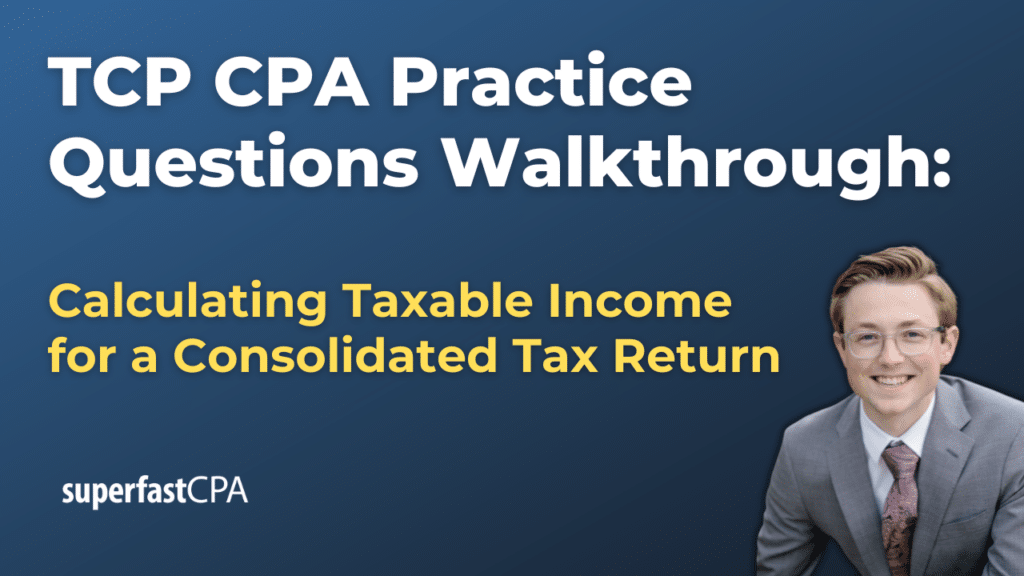In this video, we walk through 5 TCP practice questions teaching about calculating taxable income for a consolidated tax return. These questions are from TCP content area 2 on the AICPA CPA exam blueprints: Entity Tax Compliance.
The best way to use this video is to pause each time we get to a new question in the video, and then make your own attempt at the question before watching us go through it.
Also be sure to watch one of our free webinars on the 6 “key ingredients” to an extremely effective & efficient CPA study process here…
Calculating Taxable Income for a Consolidated Tax Return
Calculating taxable income for a consolidated federal Form 1120 – U.S. Corporation Income Tax Return involves several crucial steps, particularly when it comes to the elimination of intercompany transactions. Understanding these components is essential for ensuring that the consolidated tax filings accurately reflect the economic activities of the entire group without duplication from internal transfers.
Intercompany Dividends and Property Dividends Elimination
Firstly, dividends paid between entities within a consolidated group must be eliminated. This includes both cash dividends and property dividends. For example, if Company A pays a $30,000 dividend to Company B, and both are part of the same consolidated group, this dividend would not be included in the consolidated taxable income. Similarly, if any property dividends are transferred within the group, these are also eliminated. This prevents the recognition of internal group transactions that do not generate real income from external sources.
Consolidation of Operating Income
When preparing a consolidated Form 1120, all operating incomes and losses from each entity within the group are aggregated. This involves summing up all positive and negative figures.
For instance, if Corporation X reports an income of $500,000 and Corporation Y reports a loss of $200,000, the consolidated operating income would be $300,000. This step ensures that the financial results of the group are viewed as a single entity, reflecting the total economic performance.
Treatment of Intercompany Sales and Basis Transfers
Sales of assets between group entities also require careful handling. The gain or loss from such sales is not recognized until the asset is sold to an external party. The basis of the sold asset, however, is transferred from the seller to the buyer within the group.
For example, if Company C sells land to Company D within the same group for $500,000 that originally cost Company C $300,000, no gain is recognized on this intercompany sale. When Company D later sells the land to an external party for $600,000, the gain calculated ($300,000 basis results in a $300,000 gain) will be recognized for consolidated tax purposes.
Deferred Recognition of Intercompany Profits
In scenarios where assets are transferred within the group and sold externally in a different tax year, the recognition of any profit or loss is deferred until the year of the external sale.
Consider that Entity E sells machinery to Entity F in Year 1. If Entity F sells the machinery to an outside buyer in Year 2, any related gain or loss is recognized in Year 2’s tax filings.
Dividends Received Deduction (DRD)
When it comes to dividends received from outside the consolidated group, the Dividends Received Deduction (DRD) plays a crucial role in reducing taxable income.
For example, if Company G, part of a consolidated group, receives $100,000 in dividends from an unrelated company in which it holds a 25% stake, the applicable DRD might be 65%. This would mean $65,000 of the $100,000 dividend is deductible, leaving $35,000 taxable.
Example Scenario
Let’s consider a scenario to illustrate these principles: Aspen LLC and Spruce Corporation are part of a consolidated group. In Year 1, Aspen sells land to Spruce for $800,000, which had cost Aspen $500,000. In Year 2, Spruce develops the land and sells it for $1,200,000. The intercompany sale in Year 1 does not recognize any gain, maintaining the basis at $500,000. In Year 2, when the land is sold to an external party, the gain of $700,000 ($1,200,000 – $500,000) is recognized in the consolidated taxable income.
Conclusion
This overview highlights how various elements—from the elimination of intercompany transactions to the treatment of external dividends—affect the calculation of taxable income on a consolidated Form 1120. Each component ensures that the consolidated tax return accurately and fairly represents the financial outcomes of the corporate group as a whole.














